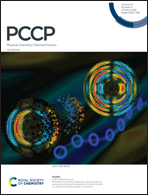Thermodynamics of small mercury clusters and the role of electronically excited states: a case study on Hg13†
Abstract
Classical Monte Carlo simulations in the isothermal–isobaric ensemble have been performed for the Hg13 cluster with the main emphasis paid to structural changes in this cluster induced by elevated temperature and pressure. Broad ranges of temperatures and pressures have been considered so that a comprehensive picture of the structural changes in Hg13 could be obtained and represented in the form of a phase diagram constructed in the temperature–pressure plane. The effect of the complex electronic structure of the cluster on its electronic ground state potential energy surface and equilibrium thermodynamics has been studied within a semi-empirical electronic structure model based on the diatomics-in-molecules approach. The involvement of (three) lowest excited electronic states has been revealed while the higher excited states available within this model do not contribute.



 Please wait while we load your content...
Please wait while we load your content...